
Home About Us Contact Us Subscribe

Home About Us Contact Us Subscribe
|
|
|
|
Healing Hearts: Genesis Heart Institute by Flad & Associates
Davenport, Iowa: A new cardiac clinic offers an environment that promotes well-being and optimism, helping patients and their families focus on healing. by ArchNewsNow September 17, 2002 The Genesis Heart Institute
in Davenport, Iowa, is home to a unique collaboration between a hospital and one
of its major physician groups to provide their shared patients with a
convenient, life-affirming facility focused on overcoming heart disease.
Genesis Medical Center and Cardiovascular Medicine, P.C. (CVM) needed a
facility that would allow them to merge cardio-diagnostic services in a
relationship as close as federal regulations would allow while maintaining
separate office space and presence for CVM physicians. Capitalizing on the
strong educational component prevalent in cardiac care, space was also needed
for medical and community education. The design team from the
Madison, Wisconsin office of Flad & Associates spent seven months with
doctors, nurses, technicians, and administrators to create an approachable,
beautiful building for the new Heart Institute. Every aspect of the
80,000-square-foot, $11 million diagnosis and treatment center, from its
location on the campus to the colors on the walls, is focused on implementing
today’s trends in healing design and medical care. Opened in October 2001, the
Institute houses cardio-diagnostics, the Phase II and III/IV rehabilitation
program, a 174-seat auditorium, physician offices, foundation offices, and a
clinical trials group. The new building was first
conceived for practical reasons – it is cost-effective to move many parts of
patient care out of the expensive hospital space and consolidate diagnostics
and rehabilitation facilities. Just as important, there is a psychological
benefit to patients recovering from heart disease in a new setting, away from
the acute treatment areas in the hospital. Sited on the campus and connected by
a glass-walled skywalk, patients are already familiar with the area, reducing
the stress and anxiety associated with starting a new phase of care after a
cardiac event. Added impetus for creating the Institute was to satisfy
physicians' desire to be close and convenient to hospitalized patients while
maintaining a busy clinic schedule. Both patients and providers
expect high-tech, but neither wants a facility that feels cold. The designers
“softened” the technology so patients feel comfortable, not threatened or
overwhelmed. The Heart Institute uses many design elements like light, color,
and spatial relationships to create an atmosphere that promotes well-being and
optimism, helping patients and their families focus on healing. Welcoming patients and
reducing stress begins with making it simple to find the Heart Institute,
especially for patients from out of town. The building’s simple rectangular
shape is enhanced by a gently curving glass curtainwall that forms the lobby at
the main entrance. White aluminum sandwich panes that bisect the form
externally link the new Institute to the rest of the campus architecture, and
create a visual landmark for patients. The three-story glass face of the lobby
greets visitors, giving them a glimpse into the building even before they
enter, and easing anxiety. Patients literally see what they’re getting into. This striking lobby, with
glass on one side and brick on the opposite wall, creates a dramatic but
peaceful space that acts as a transition between the outdoors and the treatment
areas. Three 17-foot-tall sculptural glass light fixtures double as works of
art, filling the lobby with a rainbow of soft colors and warm light when illuminated.
Waiting areas are large and light filled, with the glass curtainwall on the
south and west sides bringing sunlight deep into the facility. Furnishings in
warm, natural tones are grouped in small clusters, creating intimate settings
for patients in the open area. The interior design and finishes avoid any hint
of a white, sterile environment often associated with hospitals. The center corridor bisects
the diagnostic floor. Half the space is occupied by Genesis, the other by CVM.
Identical equipment and very similar planning will allow the floor to be fully
integrated with no renovation should laws be revised to allow for alternative
ownership. Because of their close relationship, patients may not be fully aware
of whether CVM or Genesis does their diagnostic work. The shared waiting area
for both groups prevents patients from being "in the wrong place,"
and separate but adjacent registration desks direct patients to the correct
group for testing. Forty staff members provide
diagnostic services including nuclear medicine, echocardiography, stress
testing, Holter monitors, and pediatric echocardiography. Physician offices are
located near the support staff with whom they regularly work, and physicians
now have a five-station interpretation room where they can access hospital
charts via computers. A separate reading room has four stations for reading
echoes and computers. Because the CVM physicians also perform testing for
Genesis Medical Center, they simply walk across the center corridor to see
patients. Equipment can be shared, precluding patient inconvenience during
equipment downtime. The prep rooms located
between stress testing rooms have improved patient flow by freeing up the test
rooms quicker because they aren't used as changing rooms. The nuclear medicine
rooms and cameras are conveniently located across from the pharmacy stress lab.
An oversized pediatric echo room is placed away from the rest of the diagnostic
area for quiet, and is large enough to accommodate staff and several family
members. Inpatients’ access to these diagnostic areas is provided through a
separate entry to the department via the walkway. The nurse station is open and
communal, with ample space for paperwork and computers. CVM occupies the third floor
with a clinic that has brought together 14 physicians from two separate
clinics. It has dramatically improved their operation, which serves 150 to 200
patients a day. Each physician has a private office – quite a change from
formerly shared office space. Nurses, too, are enjoying operational changes in
their work areas. Occupying the center portion of the 20,000 square feet of
space on this floor, the nurse area features partial-height walled workspaces
arranged in pods to provide individual privacy and quiet for each nurse at his
or her desk. One of the most effective
elements of the third floor plan is the design of scheduling stations at the
four corners of the nurse area. Previously, patients were escorted to the
nurses’ desks to make the next appointment, causing the nurse to clear his or
her desk of confidential documents and interrupt work unexpectedly. Now, nurses
and patients meet in this nearby “clear” space stocked with any papers
necessary to recap the visit and prepare for the next one. Nurses have praised
this approach, allowing them to give undivided attention to patients away from
the hubbub of their desks, while also freeing exam rooms quickly. Patients
appreciate not having to walk long distances in a large clinic, as everyone
they need to see is located within adjacent spaces. Dictation areas, medicine
cabinets, and EKG alcoves at the exterior of the central area are conveniently
located across the hall from the 20 exam rooms placed around the perimeter of
the floor. Each physician has three exam rooms, dictation space, and a nurse in
one area. Adjacent to the reception area is a patient education room that
doubles as a staff education room that also offers a private, comfortable space
for a waiting patient and family members. The 9,000-square-foot
cardiac rehabilitation gym on the first floor is sunny and cheerful thanks to a
full wall of south-facing windows. Bold colors and shapes create an uplifting
and invigorating space. The design was intended to motivate patients who may
spend many hours in this gym as they regain their health. Up to 16 exercising
patients can be on monitors, with planned growth for 24 when new equipment
arrives. Twenty-four patients can participate in the Phase III/IV classes. A generous waiting area with
lockers, two meeting rooms, and kitchenette takes on a coffee shop atmosphere
as patients gather before and after their classes. It is important to provide
these socialization and group teaching spaces because heart disease cannot be
conquered alone – it takes the support of medical professionals and fellow
patients to keep patients, especially newcomers, engaged in the lifestyles
changes that will support their recovery. “Patients consider the first
floor of rehab ‘their’ space,” says Manager of Cardiac Rehabilitation, Charlette
Evans. “They like the windows and the living room style environment because
it's so welcoming." She describes the psychological importance of
participating in rehab in an outpatient setting. “As patients graduate from the
acute phase to recovery, they must take more responsibility for themselves. To
see others’ success is motivating.” The main corridor leading to
the administrative offices contains several patient interview rooms for pre-
and post-rehab visits. The medical director of the Heart Institute, a surgeon,
can see patients on site without either party making separate appointments at
another location. The gallery corridor is 12 feet wide and 60 feet long, and
doubles as a test area. Wide enough for patients to walk a “loop,” the carpet has
visually appealing red stripes that aid rehab staff in conducting an important
measurement of recovery: how far a patient can walk in six minutes. A generous donation from a
local family funded the 174-seat Adler Center auditorium, named in their honor.
Although envisioned primarily for health and medical education, community
groups use the space, too. A fully equipped audio-visual facility, it is often
used three or four times a week, and will have the capability to link to the
cath labs and ORs in the hospital. Plans are underway for the auditorium to
eventually have broadcast capabilities to facilitate sharing of medical
knowledge and innovation. Steve Fish, Administrative
Director of Cardiac Services for Genesis Medical Center, describes the Heart Institute
as a place that gives patients hope, no matter what their stage of confronting
heart disease. “It's a place with a sense of solidness and permanence, telling
patients that we will be here with them as they return to health. It's also a
reflective place in the face of a life-threatening situation. The warmth and
supportive nature of the design reassures people that they can be successful.”
For physicians and healthcare providers, he adds, it is an oasis. Crossing the
skywalk from the critical world of a hospital offers a virtual walk outside
before entering the calm and uplifting environment of the Heart Institute. Architect/Landscape Architect: Flad & Associates,
Madison, Wisconsin Design Team: Fred Peterson, AIA (Principal-in-Charge/Project
Manager), Susan Olson, RA, Bill Bibo, RA (Project Architects), Kirk Keller, AIA
(Medical Planner), Louise Uehling (Interior Designer) General Contractor: Estes Company, Davenport, Iowa
|
(click on pictures to enlarge) 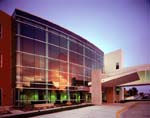 (Bob Harr, Hedrich Blessing) The curved glass curtainwall of the Genesis Heart Institute's lobby reflects the Midwest sunset.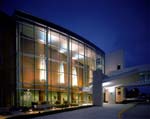 (Bob Harr, Hedrich Blessing) The lobby is a dramatic but peaceful space that acts as a transition between the outdoors and the treatment areas.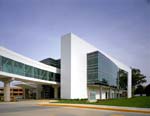 (Bob Harr, Hedrich Blessing) A glass-enclosed walkway connects the new Heart Institute to the main hospital.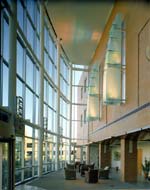 (Bob Harr, Hedrich Blessing) The 17-foot-tall sculptural glass light fixtures in the lobby double as works of art.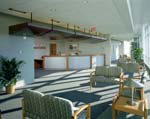 (Bob Harr, Hedrich Blessing) Small clusters of seating areas create intimate spaces.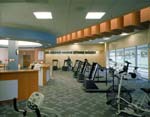 (Bob Harr, Hedrich Blessing) The cardiac rehabilitation gym on the first floor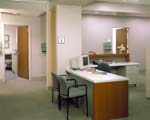 (Bob Harr, Hedrich Blessing) Scheduling stations just located adjacent to exam rooms are convenient for patients and nurses.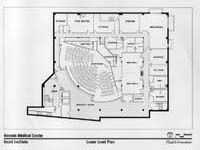 (Flad & Associates) Lower level plan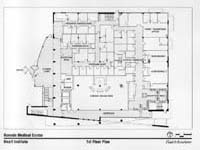 (Flad & Associates) First floor plan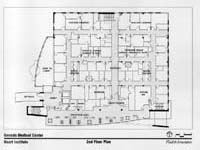 (Flad & Associates) Second floor plan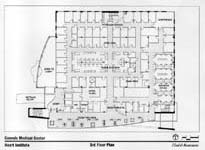 (Flad & Associates) Third floor plan |
© 2002 ArchNewsNow.com